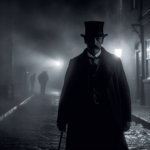Throughout history, Jack the Ripper has remained one of the most infamous and elusive serial killers. The mystery surrounding his identity and his brutal crimes continued to captivate the world since the late 19th century. So, who was Jack the Ripper? Although we can’t provide a definitive answer, we’ll explore the background of this notorious murderer and delve into the theories surrounding his identity.

In 1888, the gas-lit streets of London’s East End were terrorized by a series of gruesome and brutal murders. These killings, attributed to Jack the Ripper, targeted impoverished and vulnerable women, primarily sex workers. To this day, the killer’s identity remains unknown, as does his real motive behind the crimes. However, these unsolved murders have fueled endless speculation, and numerous individuals have been proposed as potential suspects.
The name “Jack the Ripper” was derived from a letter sent to a London newspaper in 1888, claiming responsibility for the attacks. While the letter’s authenticity has been questioned, it’s undeniable that the name caught the public’s attention and solidified the killer’s infamy. As we delve further into the mystery of who Jack the Ripper might have been, we’ll analyze the theories, examine the suspects, and try to unravel one of history’s most chilling enigmas.
The Infamous Whitechapel Murders
When discussing the chilling case of Jack the Ripper, it’s impossible to overlook the infamous Whitechapel Murders. Believed to be the work of this still unidentified serial killer, these gruesome crimes took place in the East End of London in 1888.
Five known victims, often referred to as the Canonical Five, are connected to Jack the Ripper himself:
- Mary Ann Nichols
- Annie Chapman
- Elizabeth Stride
- Catherine Eddowes
- Mary Jane Kelly
However, some argue that the true number of victims may be higher due to the nature of the crimes and the fear that it instilled in the Whitechapel area at the time.
Jack the Ripper became notorious for the brutal and gruesome nature of his attacks. He targeted female prostitutes in Whitechapel, and the murders were characterized by:
- Throat cutting
- Abdominal mutilation
- Removal of internal organs
These grisly details point to a killer with some anatomical knowledge, which has led to theories that Jack the Ripper may have been a surgeon or butcher.
Aside from the Canonical Five, there were eleven brutal murders in total within the Whitechapel district between 1888 and 1891. While these additional six cases had some similarities to those attributed to Jack the Ripper, their connections to the unknown killer are less certain:
- Emma Elizabeth Smith
- Martha Tabram
- Rose Mylett
- Alice McKenzie
- Frances Coles
- Unknown female torso
| Victim | Date of Murder | Location |
|---|---|---|
| Mary Ann Nichols | August 31, 1888 | Buck’s Row, Whitechapel |
| Annie Chapman | September 8, 1888 | Rear yard, 29 Hanbury Street, Spitalfields |
| Elizabeth Stride | September 30, 1888 | Dutfield’s Yard, Whitechapel |
| Catherine Eddowes | September 30, 1888 | Mitre Square, City of London |
| Mary Jane Kelly | November 9, 1888 | 13 Miller’s Court, Spitalfields |
Despite the passage of time and efforts made for over a century, Jack the Ripper’s identity remains a mystery. The countless theories and speculation surrounding this notorious figure continue to fuel the fascination with the Whitechapel Murders. Both amateur and professional investigators, as well as die-hard fans of cold cases, crime, and mystery, are still captivated by this infamous unsolved case.
Jack the Ripper’s Chilling Letters
Arguably one of the most chilling aspects of the Jack the Ripper case is the infamous letters attributed to the killer, which have been the subject of intense debate and analysis. During the time of the murders, the police, media, and general public received numerous letters allegedly written by the elusive serial killer. However, only a few of them stand out as potentially genuine.
The first significant letter is dated September 27, 1888, titled “Dear Boss”, which was the first time the name “Jack the Ripper” was used. Some key details from the letter include:
- Addressed to the Central News Agency
- Signed as “Jack the Ripper”
- Written confidently with numerous spelling errors
- Boasting about evading the police
- Mentioning specific details about the killings
Out of all the correspondence, the “Saucy Jacky” postcard is perhaps the most unsettling. This postcard contains details about the double murder of Elizabeth Stride and Catherine Eddowes, which occurred on the night of the 30th of September 1888. The postcard, received October 1, 1888, could not have been a hoax, as the facts were not public knowledge yet.
A third significant letter is the “From Hell” letter, received on October 15, 1888 by George Lusk, president of the Whitechapel Vigilance Committee. The letter included a small cardboard box with a chilling addition – half a human kidney preserved in wine. The authenticity of this letter is still debated, but it remains a disturbing part of the story.
In summary, the three key letters that could potentially have been written by Jack the Ripper are:
- Dear Boss (September 27, 1888)
- Saucy Jacky postcard (October 1, 1888)
- From Hell (October 15, 1888)
There are many other letters, but they are mostly regarded as hoaxes rather than authentic works of the killer. It’s important to note that while these letters might be genuine, it’s also possible that they were either the work of journalists trying to create sensationalism or pranksters taking advantage of the public’s fascination with the case.
Regardless, Jack the Ripper’s letters add an eerie element to an already terrifying and unresolved mystery, giving us a chilling insight into the mind of someone capable of committing such brutal crimes.
Prime Suspects in the Ripper Case
As the identity of the infamous Jack the Ripper remains unsolved, we’ve delved into the most widely-discussed prime suspects in the case. With their own unique backgrounds and reasons for being linked to the murders, these figures have piqued the interest of many true crime aficionados. Here are the top four suspects who may have been the notorious serial killer:
- Aaron Kosminski: A Polish-Jewish barber, Kosminski was believed to have suffered from paranoid schizophrenia. A well-known suspect, his mental illness and residence in Whitechapel made him a prime subject.
- Montague John Druitt: This English barrister and teacher’s suspicious timing of his suicide piqued the interest of investigators. His death took place just after the last murder and his profession would have given him enough knowledge to carry out the killings.
- Thomas Cutbush: A troubled individual, Cutbush was detained in an insane asylum. It’s said he had a fascination with knife attacks on women, making him a potential suspect. There were also claims that his aunt helped cover up his crimes.
- Dr. Francis Tumblety: An American physician with a rather checkered past, Tumblety was known for performing abortions and had a disdain for women. Although he was arrested and considered suspicious, he eventually escaped and fled to the United States.
The question of who Jack the Ripper was persists as an enduring mystery. Below is a compact summary of our prime suspects:
| Suspects | Occupation | Key Facts |
|---|---|---|
| Aaron Kosminski | Barber | Paranoid Schizophrenic, Lived in Whitechapel |
| Montague John Druitt | Barrister, Teacher | Suicide coincided with last murder |
| Thomas Cutbush | Unemployed | Insane asylum detainee, knife fascination |
| Dr. Francis Tumblety | Physician | Abortions, disdain for women, escaped authorities |
Over the years, these prime suspects and many others have been analyzed by experts, but the identity of Jack the Ripper continues to elude us. Detailed theoriesand examinations of evidence from the time of the murders are ongoing in the hopes of finally closing this thrilling mystery. Cold case enthusiasts and crime buffs continue to dig into the chilling story of Jack the Ripper, searching for that elusive proof that might reveal the killer’s true identity.
Victorian London: The Ripper’s Hunting Ground
Victorian London was a city of contrasts. The rich enjoyed lavish lifestyles while the poor struggled to survive in squalid conditions. It’s in this environment that Jack the Ripper, one of history’s most notorious serial killers, found his hunting ground. We’ll delve into the backdrop of his crimes, painting a picture of the city where he operated.
The East End, the Ripper’s primary hunting ground, was a densely populated area filled with slums and poverty-stricken communities. Many people lived in cramped, unsanitary quarters, making disease and crime rampant. This environment provided the perfect cover for a predator like Jack the Ripper.
A lack of adequate policing also contributed to the Ripper’s ability to operate undetected. During the 1880s, the Metropolitan Police was stretched thin, with a shortage of officers and resources. This created an opportunity for criminals, including the Ripper, to evade capture.
Some key aspects of Victorian London that allowed the Ripper to thrive were:
- Population density: London had a population of approximately 4.4 million people in the 1880s.
- Economic disparity: The gap between the rich and poor was vast, with many living in extreme poverty.
- Limited lighting: Gas lamps provided limited street lighting, allowing criminals to operate in darkness.
- Prostitution: Desperate circumstances led many women to engage in prostitution, making them easy targets for the Ripper.
| Population | Wealthy Class | working Poor |
|---|---|---|
| 4.4 Million | 5% | 95% |
The conditions in Whitechapel, the epicenter of the Ripper’s crimes, were particularly bleak. Here, we saw overcrowded tenements, limited access to clean water and sanitation, and high levels of unemployment. Residents often turned to unhealthy coping mechanisms, like alcohol, to escape their desperate realities.
With such a despairing environment, it’s no wonder that the police faced immense challenges in identifying and catching the elusive Jack the Ripper. He was a predator who took advantage of the widespread desperation and darkness of Victorian London to commit his brutal and horrific crimes.
As die-hard fans of cold cases, crime, and mystery, exploring the world of Victorian London gives us incredible insight into the Ripper’s motivations and methods. Furthermore, it helps us understand how a city in turmoil provided the ideal hunting ground for one of history’s most infamous killers.
Investigative Techniques and Challenges
In the late 1800s, investigative techniques were nowhere near as advanced as they are today. As a result, the detectives working on the Jack the Ripper case faced a multitude of challenges. One of the most significant issues was the lack of forensic science. This meant that investigators of the time couldn’t rely on methods like DNA analysis or fingerprinting, as these techniques hadn’t yet been developed.
Additionally, the sheer volume of suspects made the task of identifying the killer extremely difficult. In total, there were over 100 individuals suspected of being Jack the Ripper, but only a few seemed likely to be the actual murderer. Some of the more prominent suspects included:
- Aaron Kosminski: a Polish barber and resident of Whitechapel, deemed insane by some
- Montague John Druitt: an English lawyer who committed suicide a month after the last murder
- Dr. Francis Tumblety: an American physician with a history of criminal activity
Another obstacle faced by the investigators was the sensationalist reporting of the case by the media. Many newspapers at the time exaggerated details or fabricated stories, making it difficult for experts to separate fact from fiction.
| Year | Forensic Technique | Status |
|---|---|---|
| 1888 | DNA analysis | Not yet invented |
| 1888 | Fingerprinting | Not yet in use |
| 1888 | Forensic ballistics | Not yet developed |
Furthermore, the inadequate communication between different police jurisdictions complicated the matter even more. The Metropolitan Police (Scotland Yard) and City of London Police didn’t share all of their information with each other, which led to inefficiencies in their investigations. If both forces had effectively collaborated, they might have had a better chance of capturing the notorious killer.
In summary, the investigators of the Jack the Ripper case were faced with numerous challenges, such as:
- The lack of modern forensic techniques
- The large number of suspects
- Sensationalist media coverage
- Poor communication between police forces
These factors all contributed to the fact that, even after more than a century, we still don’t know for certain who was Jack the Ripper. Although the investigation was extensive, it seems the identity of this infamous serial killer will likely remain shrouded in mystery.
Who was the true Jack the Ripper?

The true identity of Jack the Ripper remains unknown. Despite numerous theories and suspects, no one has been definitively proven to be the infamous serial killer who terrorized London in the late 1800s.
Conclusion: The Enduring Mystery of Jack the Ripper
After examining the numerous suspects and theories surrounding the identity of Jack the Ripper, we can’t help but feel captivated by the enduring mystery that shrouds this infamous figure. Despite our best efforts and countless investigations, the true identity of the killer remains uncertain.
Throughout this article, we’ve delved into:
- The historical context that facilitated the violent crimes
- Various theories that seek to unmask the killer’s identity
- Detailed information regarding suspects who could be the Ripper
Although the case has fascinated us for over a century, uncovering the mystery of Jack the Ripper still proves to be an elusive task. Several difficulties impede our progress towards finding the truth:
- Lack of concrete evidence: The passage of time has eroded much of the direct evidence that could have helped identify the killer.
- Evolving forensic techniques: The investigation took place during an era when modern forensic technology wasn’t available, which severely limited the authorities’ ability to gather solid data.
Despite these challenges, we continue to be enthralled by the case. This enduring fascination speaks to our collective curiosity and the human desire to solve puzzles. We’re passionate about crime mysteries, and the enigma of Jack the Ripper is the epitome of an unsolved case that has captured the imagination of generations.
With each new lead and revelation, we eagerly await the moment when the truth finally comes to light, hoping to find closure for the victims and their loved ones. Until then, we’ll continue to explore every detail, no matter how small, in our relentless pursuit of answers.
For die-hard fans of cold cases, crime, and mystery, the exploration of the Jack the Ripper saga is a journey worth taking. This masterpiece of unsolved criminal history provides a plethora of fascinating data to analyze and discuss in our quest to fill the gaps in our understanding.
In the end, the world may never know the true identity of Jack the Ripper, but the chilling tale of the Whitechapel murderer will forever be immortalized in the annals of crime, mystery, and cold cases.
References:
https://www.jack-the-ripper.org/
https://en.wikipedia.org/wiki/Jack_the_Ripper

Owner & entrepreneur with a passion for murder mystery! Seriously, who doesn’t love murder mystery?
Chris is a proud member of the American Medical Writer’s Association (AMWA), the International Society for Medical Publication Professionals (ISMPP), the National Association of Science Writers (NASW), the Council of Science Editors, the Author’s Guild, and the Editorial Freelance Association (EFA).

